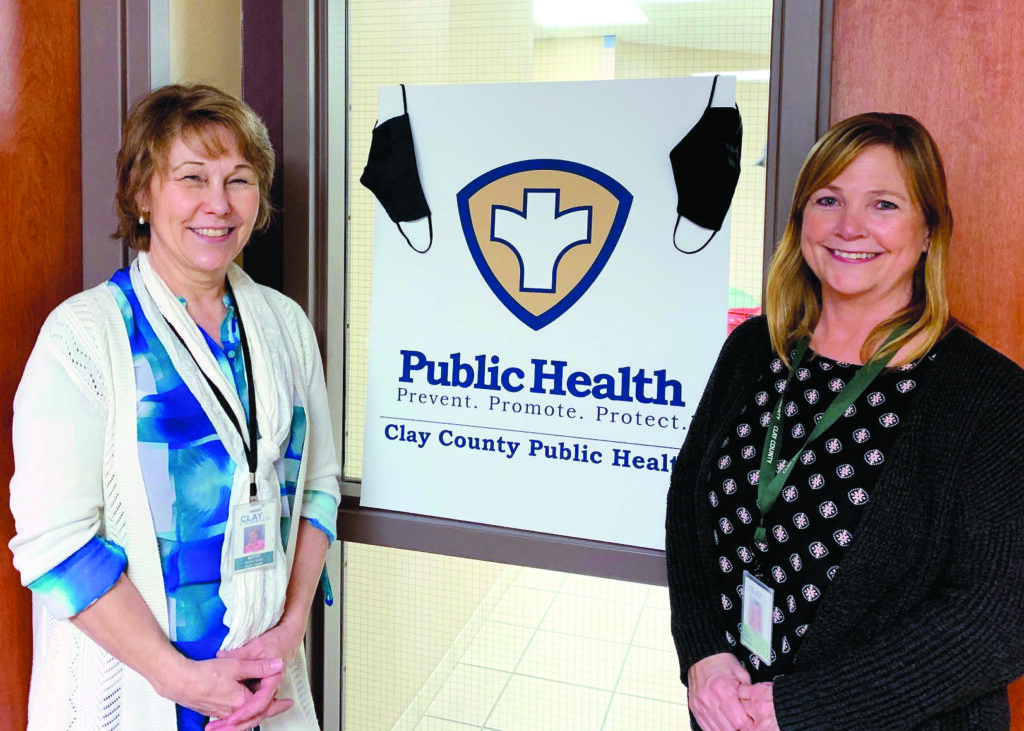
Clay County Public Health director Kathy McKay and nursing director Jamie Hennen have led the local fight against the coronavirus since January 2020. Photo/Nancy Hanson
Nancy Edmonds Hanson
Three years ago, word had just begun to filter across America about an unknown virus erupting half a globe away.
“The World Health Organization had begun talking about a deadly new virus in December,” Clay County Public Health administrator Kathy McKay remembers. “We were hearing about it before it reached Minnesota. We’d been doing exercises preparing for pandemics for years and years, so we weren’t entirely unprepared. But we had no idea at that point how this would turn out.”
Over the next two months, as the drumbeat grew louder, that would become increasingly clear. Cases of COVID-19 jumped the Pacific Ocean despite a ban on travel from China in January. And on March 6, 2020, Kathy and director of nursing Jamie Hennen were on their way to a meeting of the Moorhead City Council when they got the word from St. Paul: Minnesota had just recorded its first presumed case of the novel coronavirus.
And just like that, the two Moorhead RNs and their colleagues were thrust onto the front lines of a life-or-death battle that would ultimately take 134 Clay County lives … and, as of Tuesday, 14,320 Minnesotans and 1,118,484 American from coast to coast.
Says McKay, “It definitely rocked our world.”
Large-scale health emergencies were nothing new to Public Health. “We had a little experience of it in 2009 with the H1N1 epidemic,” Hennen reports. But the circumstances of what was commonly called “swine flu” were nothing like COVID-19: “Things went well. We had vaccines, we had the personnel, and we just kept pushing them out. Everyone was on board.”
McKay adds, “We worked night and day during the massive flooding that year, too, but we played a support role. We were moving people out of nursing homes and evacuating hospice patients. It was very challenging. But it didn’t go on for months and months … or years.”
The COVID pandemic called for a different approach, starting with setting up an incident command structure involving the entire public health team. Was it enough? “Looking back, I feel we needed a lot more,” she concedes. “We needed relief.”
Instead, the two nurses became regulars at meetings all over the county. They were first on the Clay County Commission agenda every week for more than two years and reported frequently to the Moorhead City Council. They met with school superintendents around the county. That meant that they were called upon to parry the most frequent question asked during the early days: Just who and where were the COVID cases occurring? “There was a lot of pressure to give out information that we just could not provide,” McKay remembers. “People were panicking. But ethically, we cannot share that.”
They took part in the Fargo-Moorhead COVID task force with their counterparts across the river — and sometimes butted heads with Fargo-centric or Minnesota-centric rules that were at odds with what they saw as common sense. Hennen and McKay suggest that, at first, Minnesota Health Department officials didn’t understand the unique situation in Fargo-Moorhead. “We’re probably unique in Minnesota in that all of our health-care providers are on the other side of the river,” Hennen says.
They are grateful that North Dakota’s chief operating officer, Tammy Miller, was a staunch advocate of including Clay County residents in North Dakota’s efforts and vice versa. One example: Opening the Vault testing site in Moorhead to all residents, no matter what state they called home. Another: North Dakota’s offering vaccination, when it became available in 2021, to students not only at NDSU but also to Moorhead collegians. It was a reversal of Minnesota’s approach during the first push for vaccinations, when teachers and school staff members were given priority for the preventive shots — but only those from the east side of the river.
Three years into the COVID era, the statistics lay out a herculean tale of massive testing and immunization, despite the politicized opposition that inevitably spread from the national level to the local scene. Of Clay County’s 60,000 residents, 41,340 of residents over 6 months of age (65.1%) have had at least one vaccine dose. Just under 40,000 (59.9%) have had the complete series, but only 14.6% (9,246) are up to date on all available shots. That compares with 72% of all Minnesotans with one dose, 67.6% with the complete series and 18.9% with all shots, including boosters.
Yet COVID-19 continues to roll on, joined this fall by RSV and influenza. Clay County Public Health continues to offer weekly clinics. Though the numbers are far less than they were a year ago, residents do continue to come in.
“We need to take into account what we’ve learned through COVID,” McKay says. “It’s unrealistic to think we should wear masks for the rest of our lives, but it makes sense to continue the basics. Wash wash wash your hands. Cover your mouth. Stay home if you’re sick. If you’re at high risk, wear a mask when you’re out among crowds.”
Hennen — who plans to retire next month after 38 years in public health — echoes her advice. “We need to use the lessons we’ve learned over these years. Some are actually what we’ve always known we should do to keep ourselves, and others, healthy.”


